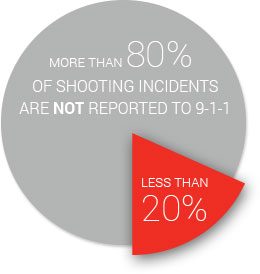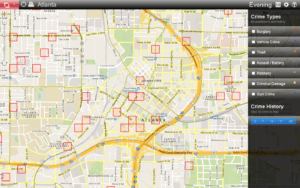Digitally enabled policing: redefining incident identification, response, and prediction

Digital technology is changing the world of policing. The Boston Police Department (BPD), like its peers throughout the US and the world, is adapting its operating model to leverage new digital tools and approaches in traditional policing contexts and to prepare for new policing contexts which will be created by digital technology (e.g., cybercrime). While the BPD is close to the leading edge of this adaptation, there is more that it could be doing.
The Boston Police Department (BPD) and its peers create value by protecting and improving public safety – they enable value creation and capture by a diverse set of other actors.[i] To deliver on this customer promise, BPD traditionally leveraged the standard policing operating model – (1) incident identification, (2) incident response, and (3) incident analysis/prediction – with a heavy emphasis on humans as sensors for identification (i.e., police officers, citizens) and largely relying on intuition (informed by basic data analysis) to determine incident response and drive incident analysis/prediction. Digital sensors, the data they capture, and new capability to analyze that data (and combine it with other sources of data) are turning the traditional model on its head:
(1) Incident identification: Traditionally, incidents have been identified through unreliable call-ins (e.g., 911) and radio-ins from police patrols.[ii] Several digital technologies are replacing humans as sensors, removing the necessity for call/radio-in, and providing deeper initial incident understanding. Foremost among these is ShotSpotter, employed by the BPD and several other large city PDs; ShotSpotter uses a system of microphones deployed throughout a city (e.g., on lightposts) which detects gunshots, triangulates their origin location, and rapidly feeds it to BPD’s Real Time Crime Center and officer squad cars/mobile devices – nearby security cameras, ATM cameras etc. can be quickly be trained on the location to provide officers with ingoing situational awareness (e.g., suspect identification, license plate reading).[iii] Additionally, any repeat offenders wearing GPS tracking bracelets can be quickly identified if they are in the area of the shot.[iv] Shotspotter (and other passive sensing technologies) ensure that incidents don’t go unreported and lead to faster, more informed police mobilization/arrival on scene.[v]
Figure 1: How ShotSpotter works[vi]
[2] Incident response: Digital technology is transforming the safety, effectiveness, and accountability of on-scene response. Traditionally, officers communicated by keyed radio, making it difficult to quickly convey developments (e.g., officer downs). New digital technologies have the potential to ensure that officers get help more quickly when needed and to enable coordination between multiple officers responding to complex incidents: wearables track officers’ vitals/stress indicators and can signal when an officer/canine unit is under duress, passive alcohol/drug sensors inform whether offenders are intoxicated, sensor-enabled gear-belts notify when officers draw a weapon, body cameras provide live views into the officer’s/canine’s surroundings and identify potentially threatening shouting/ loud voices, drone mounted cameras provide an overhead view, and officer specific GPS allow for coordinated tracking and deployment. Additionally, these technologies collect diverse data on the quality of the response – both operational quality (to inform later training) and legal quality (to ensure that offenders’ rights are not violated/ officers cannot be unfairly accused of unprofessional actions). Additional technologies are also enhancing response by enabling more effective tracking of offenders should a pursuit occur during incident response. Car/hand launched GPS tracking darts are being deployed early in police vehicle pursuits to reduce the risk associated with high speed chases.[vii] More controversially, IMSI-catchers (devices which essentially simulate cell towers in order to get all nearby cell phones to identify themselves and their locations) are being used to identify where suspects are hiding.[viii] Incident response has always been fraught with danger for officers, offenders, and civilian bystanders – these digital technologies have the potential to enable better management of the risks associated with response.
[3] Incident analysis/prediction: Incident identification/response in a digitally enabled age generate significant data, which can be combined with other data sources (e.g., social media) to guide live response and to predict where/when crimes are likely to occur in the future. Data analytics firms (e.g., Palantir, PredPol) are combining these disparate data sources and setting up repeatable analyses that help the BPD better anticipate where/when incidents are likely to occur and to guide police action within a given incident response (e.g., predictive heat maps, maps of hate speech tweets).[ix][x] Combination of data sources (including unconventional ones) and cutting edge data analytics is a big step forward from a traditional model which operated largely on ad hoc data analysis and intuition.[xi]
Figure 2: PredPol predictive crime map[xii]
While the BPD and its peers have made early strides leveraging digital technology to improve their operating models more can be done: opportunities to embed digital incident identification sensors in new city infrastructure (e.g., parking meters, smart pavement) should be thoughtfully considered and data analysis tools – especially around incident prediction – should be invested in and built into standard operating procedures/workflows (so they are more than expensive toys). [xiii] Additional will be needed to deliver on an inevitable expansion of BPD’s customer promise: protecting/improving public safety in the digital realm. Several police departments, including recently Newark’s, have seen their increasingly digitally-enabled operating models temporarily undermined by cybercrime/sabotage. [xiv] BPD and its peers will need to harden their own systems against cybercrime, and develop the digital tools to identify, respond to, and analyze/predict cybercrimes affecting the broader citizenry.
[790 words]
[i] BPD states its mission as “working in partnership with the community to fight crime, reduce fear and improve the quality of life in our neighborhoods.” http://bpdnews.com/mission-and-objectives/
[ii] Call-ins are not always made in a timely fashion (and sometimes not made at all, even for the most serious incidents e.g., shootings, only 20% of which are reported. ShotSpotter. http://www.shotspotter.com/law-enforcement
[iii] ShotSpotter. http://www.shotspotter.com/law-enforcement
[iv] “Cameras, GPS, help BPD fight crime” NECN. http://www.necn.com/news/new-england/_NECN__Cameras__GPS_Technology_Help_Boston_Police_Combat_Crime_NECN-247633921.html
[v] In New Haven, CT shooting homicides are down 55% and non-fatal shooting homicides are down 52% post –installation of Shot Spotter. City Spotlight. ShotSpotter. http://www.shotspotter.com/law-enforcement
[vi] ShotSpotter. http://www.shotspotter.com/law-enforcement
[vii] Starchase Pursuit Management. http://www.starchase.com/
[viii] The Stingray’s tale. Economist. http://www.economist.com/news/united-states/21689244-courts-take-aim-technology-beloved-countrys-police-forces-secretive
[ix] Palantir Law Enforcement. https://www.palantir.com/solutions/law-enforcement/
[x] Predpol: predictive policing. http://www.predpol.com/
[xi] “Don’t even think about it” Economist. http://www.economist.com/news/briefing/21582042-it-getting-easier-foresee-wrongdoing-and-spot-likely-wrongdoers-dont-even-think-about-it
[xii] Predpol: predictive policing. http://www.predpol.com/
[xiii] Internet of Things in Government. Deloitte. https://dupress.deloitte.com/dup-us-en/focus/internet-of-things/iot-in-government.html#endnote-sup-24
[xiv] “Cyber attack temporarily shut down Newark police computer systems.” NJ.com http://www.nj.com/essex/index.ssf/2016/04/cyber_attack_shuts_down_newark_police_computer_sys.html#incart_river_index






Great post! I think the first two components (incidence identification and response) can create great value to the public and increase safety. I have mixed emotions regarding the predictive measures. Using forecasting to prevent crimes raises many privacy and equality issues. One risk is targeting the wrong individuals as potential future criminals. Though it sounds like a scene taken from ‘Minority Report’, it actually happened in Chicago (For more details on the Chicago PD system and some of its shortcomings: http://articles.chicagotribune.com/2013-08-21/news/ct-met-heat-list-20130821_1_chicago-police-commander-andrew-papachristos-heat-list). The Chicago PD uses a predictive software that creates a ‘heat list’ of 400 individuals who are most likely to commit violent crime. But this software is not perfect. How would you feel if a policeman approached you and warned you even before you have done anything wrong? Or in the case of this article and the predictive crime map – will you be discriminated by the police just for being at the wrong place?
Interesting post JPW. I am glad to hear law enforcement agencies are starting to embrace technological advances. I know the mounted cameras have caused a lot of controversy as of late, but seem like an intelligent way to stem excessive force used by officers. After reading about the cameras and microphones, I can’t help but think of a Big Brother scenario in which government agencies are essentially spying on their citizens. It seems there needs to be a careful balance struck between having a watchful eye to prevent crime and not infringing on citizens’ civil liberties. I am curious to see how this shapes out in the near future.
Great post JPW! It is impressive to see how sophisticated have law-enforcement agencies become. This allows for a much more precise action while also reducing non-compliance with procedures. These technologies offer particular hope for cities in which corrupt or inefficient street police officers are one of the sources of incident identification: by relying more and more on automated sensors, you reduce the need for human intervention, thus allowing centralized operations centers to deploy adequate measures to respond to incidents. Let’s hope this advances will channel through to the places that are in most need of them.
Interesting post! Your post on BPD makes me realize that digitalization is really changing every single aspect of our lives. Seamless connectivity among multiple devices allows instant communication and better responses. However, as Eric mentioned above, it seems difficult to draw the line between privacy and public safety. Also, any hack into the system would undermine safety of the entire city. As BPD implements these technologies, they will need to do deep and thorough due diligence.
It’s heartening to see how technology is being used to advance crime prevention, reduction and response rate. The ShotSpotter technology particularly reminded me of superhero movies like Superman/Spiderman in the ability to detect crime based on sound sensors. That it would one day become a reality, I had never thought. I am wondering how scalable this is. The investment in gadgets coupled with the intricate infrastructure layout needed to make this work would require time and a long term commitment from law enforcement agencies and the government. I am also curious too see if any pilot has been done to determine the practical application of this system to weed out any loopholes and drive efficient operations. The loss of privacy and potential cybercrime is worrisome and before rolling this out it would be prudent to institute protection into existing police hardware and software.
JPW, Thanks for sharing insights into how the BPD is improving their policing through technology – truly fascinating. Policing is an interesting use of this technology. Especially given the recent uptick in negative feelings towards police, these digital tools will help them in better assessing and countering threats. This should also help alleviate some concerns on the other side, because police departments and cities can point to actual data and video, for example, in explaining actions. As I mentioned in some other posts, I wonder what else they can use this technology for? If they are embedding these technologies throughout cities, there are likely additional ways to monetize, in a way that can help the city pay for the implementations of other related technologies that make our cities safe. Perhaps they can sell traffic data to retailers? Yes, it would be fraught with privacy concerns, but that can likely be worked out in time. They could also use the data to help in determining which areas to develop, what they can charge developers for, etc. Ultimately, once the infrastructure is built, cities should look for ways to make money off it, so that efforts can be put to improving other aspects of day-to-day life.